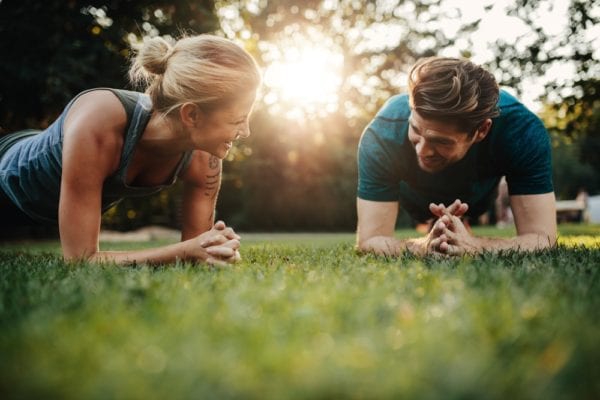
It is not possible for athletes to perform at their highest level while suffering from joint pain. Athletes put an incredible amount of strain on their joints, but the muscle-building exercises they do may actually be able to strengthen joints.
Here is some information about how muscle strengthening around the joints can help alleviate joint pain in athletes.
Connection Between Muscles & Joints
Not only is joint pain caused by an injury to the joint, but also to the tissues that surround it.1,2 When this happens, pain, stiffness, inflammation, and decreased the range of motion can occur. Joints are made up of bones that are connected by a tendon, and tissues support that connection. Ligaments connect muscles to the bones, so when one of these components is affected, they can all suffer.
Joints rely upon muscles to support them,3 so an athlete can help to support the joints by strengthening the muscles that surround them.4,5 After an injury, it is often recommended that athletes do muscle strengthening exercises to build up the range of motion and reduce pain symptoms.
Joint Pain Regions for Athletes
The most common site of joint pain for athletes is the knees.6 However, shoulders, hips, fingers, and other joint regions can also be affected. Direct physical injury is not uncommon for athletes. But joint pain can also result from the onset of osteoarthritis and poor exercise technique.
Joint and Muscle Strengthening Exercises
It is important for athletes in any sport to engage in muscle strengthening exercises that have positive effects on the joints.4 This is crucial for a range of motion, longevity, and injury prevention. By simply stretching, an athlete can improve flexibility, reduce tension, and prepare the body for exercise.6,7
Here are some exercises that will aid in muscle strengthening that support key joints needed for athletic performance and can help alleviate joint pain.
Wall Squats for Knees
Athletes who suffer from joint pain in the knees can strengthen the muscles that support the knees with wall squats.8 To do this exercise, one should stand with the back against the wall and with the feet hip-width apart and about two feet out from the wall. Slide down the wall until a sitting position is reached. Hold this position for 10 seconds, slide back up, and repeat 10 times. Make sure that the knees do not extend over the toes, and hold the abdominal muscles tight.
Side Leg Raises for Hips
The hips are necessary for running, jumping, and many other athletic pursuits. Athletes can strengthen the hips and glutes by lying on one side with the legs stacked on top of each other.8 Lift the leg on top to about a 45-degree angle and then lower it to the ground. This exercise can be repeated 15 to 20 times on each side and increased as strength is built up.
Draw the Sword for Shoulders
Rotator cuffs are particularly problematic for athletes, and this “draw the sword” exercise can help strengthen the muscles that support shoulder joints.9 Hold a dumbbell in one hand and place it palm-down on the opposite thigh. With the arm straight, draw it across the body outwards and upwards to the opposite shoulder. Then return to the starting position and switch sides.
REFERENCES for JOINT PAIN THROUGH MUSCLE STRENGTHENING
1. Joint pain. MedlinePlus. Retrieved October 23, 2018 from https://medlineplus.gov/ency/article/003261.htm.
2. Villa-Forte, A. (2017 December). Joint pain: Single joint. The Merck Manual: Consumer Version. Retrieved October 23, 2018 from https://www.merckmanuals.com/home/bone,-joint,-and-muscle-disorders/symptoms-of-musculoskeletal-disorders/joint-pain-single-joint.
3. Bones, muscles and joints. Healthdirect. Retrieved October 23, 2018 from https://www.healthdirect.gov.au/bones-muscles-and-joints.
4. Lorenz, D. S. & Reiman, M. P. (2011 September). Integration of strength and conditioning principles in a rehabilitation program. International Journal of Sports Physical Therapy, 6, 241-253. Retrieved October 24, 2018 from National Center of Biotechnology Information https://www.ncbi.nlm.nih.gov/pmc/articles/PMC3164002/.
5. How exercise helps your joints. Arthritis Foundation. Retrieved October 24, 2018 from http://blog.arthritis.org/living-with-arthritis/exercise-benefits-for-joints/.
6. Villalobos, A. & Patel, D. R. (2017 July). Evaluation and management of knee pain in young athletes: overuse injuries of the knee. Translational Pediatrics, 6, 190-198. Retrieved October 24, 2018 from National Center of Biotechnology Information https://www.ncbi.nlm.nih.gov/pmc/articles/PMC5532199/.
7. Warm up, cool down and be flexible. American Academy of Orthopaedic Surgeons. Retrieved October 23, 2018 from https://orthoinfo.aaos.org/en/staying-healthy/warm-up-cool-down-and-be-flexible/.
8. Bracilovic, A. (2011 June 14). Knee strengthening exercises. Arthritis Health. Retrieved October 24, 2018 from https://www.arthritis-health.com/treatment/exercise/knee-strengthening-exercises.
9. Stankowski, J. Shoulder more weight. Men’s Journal. Retrieved October 24, 2018 from https://www.mensjournal.com/health-fitness/shoulder-more-weight/.
